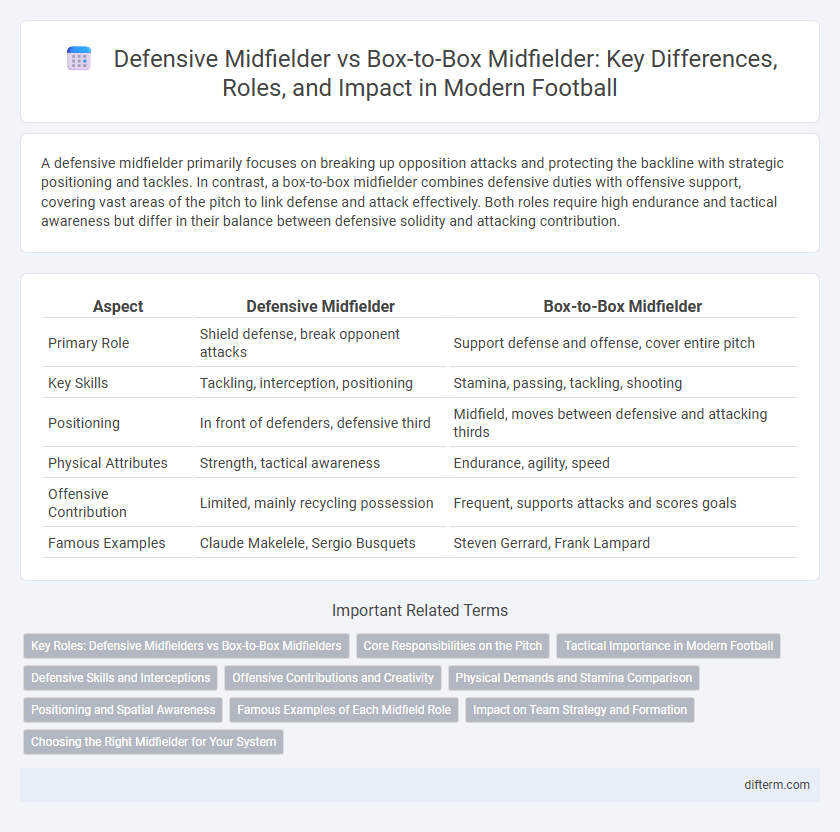A defensive midfielder primarily focuses on breaking up opposition attacks and protecting the backline with strategic positioning and tackles. In contrast, a box-to-box midfielder combines defensive duties with offensive support, covering vast areas of the pitch to link defense and attack effectively. Both roles require high endurance and tactical awareness but differ in their balance between defensive solidity and attacking contribution.
Table of Comparison
| Aspect | Defensive Midfielder | Box-to-Box Midfielder |
|---|---|---|
| Primary Role | Shield defense, break opponent attacks | Support defense and offense, cover entire pitch |
| Key Skills | Tackling, interception, positioning | Stamina, passing, tackling, shooting |
| Positioning | In front of defenders, defensive third | Midfield, moves between defensive and attacking thirds |
| Physical Attributes | Strength, tactical awareness | Endurance, agility, speed |
| Offensive Contribution | Limited, mainly recycling possession | Frequent, supports attacks and scores goals |
| Famous Examples | Claude Makelele, Sergio Busquets | Steven Gerrard, Frank Lampard |
Key Roles: Defensive Midfielders vs Box-to-Box Midfielders
Defensive midfielders primarily focus on breaking up opposition attacks, shielding the defense, and maintaining positional discipline to intercept passes and tackle opponents effectively. Box-to-box midfielders cover extensive ground, contributing both defensively by tracking back and offensively by supporting attacks, often acting as a vital link between defense and forward players. Their dual role demands high stamina and versatility to balance defensive duties with creative playmaking and goal-scoring opportunities.
Core Responsibilities on the Pitch
Defensive midfielders prioritize breaking up opposition attacks by intercepting passes, making tackles, and shielding the defensive line, while maintaining positional discipline to protect the back four. Box-to-box midfielders cover large areas of the pitch, contributing to both defense and attack by supporting forward plays and tracking back to recover possession. Core responsibilities of defensive midfielders center on ball recovery and distribution, whereas box-to-box midfielders balance defensive duties with initiating offensive transitions.
Tactical Importance in Modern Football
The defensive midfielder anchors the team by breaking up opposition attacks and providing a shield in front of the defensive line, ensuring defensive solidity and tactical discipline. In contrast, the box-to-box midfielder contributes dynamically by linking defense and attack, covering extensive ground to support both phases of play, which adds versatility and fluidity to team transitions. Modern football demands these roles adapt strategically, with defensive midfielders often initiating build-up play and box-to-box midfielders balancing stamina with tactical intelligence to influence multiple areas on the pitch.
Defensive Skills and Interceptions
Defensive midfielders excel in tactical positioning and intercepting passes, often breaking up opposition attacks through timely tackles and anticipation. Box-to-box midfielders possess a balanced defensive skill set but prioritize mobility, covering more ground to support both defense and attack transitions. Their interception rates tend to be lower compared to dedicated defensive midfielders, who specialize in shielding the back line and disrupting offensive plays.
Offensive Contributions and Creativity
Defensive midfielders primarily focus on breaking up opposition attacks and maintaining team structure, which limits their direct offensive contributions and creative impact. In contrast, box-to-box midfielders actively participate in both defense and attack, often contributing key passes, assists, and occasional goals due to their dynamic positioning and higher involvement in forward play. Their ability to transition quickly between defense and offense significantly enhances a team's creativity and attacking options.
Physical Demands and Stamina Comparison
Defensive midfielders require exceptional stamina to maintain intense concentration and physical challenges throughout the match, often engaging in breaking up opposition plays and shielding the defense. Box-to-box midfielders demand superior physical endurance and explosive power to transition rapidly between defensive duties and attacking support, covering greater distances on the pitch. The continuous high-intensity running and frequent directional changes make the stamina requirements for box-to-box midfielders more dynamic compared to the sustained physicality needed for defensive midfielders.
Positioning and Spatial Awareness
Defensive midfielders excel in positioning by maintaining a deep stance in front of the defense, effectively cutting passing lanes and shielding the backline. Box-to-box midfielders demonstrate advanced spatial awareness by covering large areas of the pitch, transitioning seamlessly between defensive duties and attacking support. Their ability to read the game enables precise interception timing and optimal positioning during both offensive build-up and defensive recovery.
Famous Examples of Each Midfield Role
N'Golo Kante exemplifies the defensive midfielder role with his exceptional ball-winning skills and ability to shield the defense, while players like Sergio Busquets demonstrate precise positional awareness and playmaking from deep. In contrast, box-to-box midfielders such as Steven Gerrard and Yaya Toure excel in covering large areas of the pitch, contributing both defensively and offensively by supporting attacks and tracking back. These distinctive roles highlight the balance between defensive solidity and dynamic involvement in midfield transitions in modern football.
Impact on Team Strategy and Formation
Defensive midfielders anchor the team's defensive structure by breaking up opposition attacks and maintaining positional discipline, allowing for a more stable backline and enabling fullbacks to advance confidently in formations like 4-2-3-1. Box-to-box midfielders influence team strategy by contributing dynamically to both defense and attack, providing energy in transitions and supporting offensive plays while still tracking back, ideal for flexible formations such as 4-3-3 or 3-5-2. Integrating either type affects pressing intensity, midfield balance, and overall tactical fluidity, shaping how a team controls possession and counters opposition threats.
Choosing the Right Midfielder for Your System
Defensive midfielders excel in breaking up opposition attacks, providing essential protection for the backline with strong tackling and positional awareness, making them ideal for systems prioritizing a solid defense. Box-to-box midfielders offer dynamic transitions by contributing both offensively and defensively, leveraging stamina and versatility to support attacking plays while tracking back. Selecting the right midfielder depends on the team's tactical approach: a defensive midfielder suits possession-based or low-block systems, whereas a box-to-box midfielder thrives in high-tempo, pressing styles demanding continuous movement.
defensive midfielder vs box-to-box midfielder Infographic

 difterm.com
difterm.com